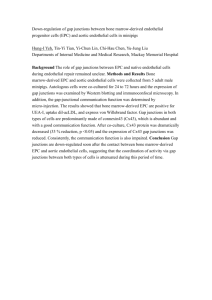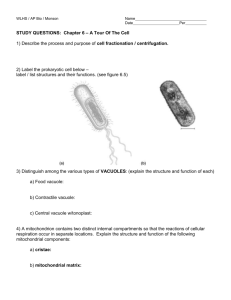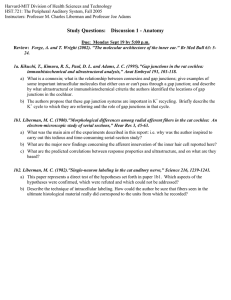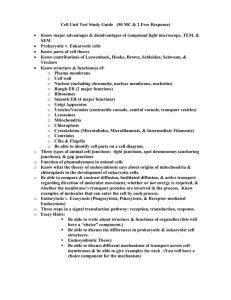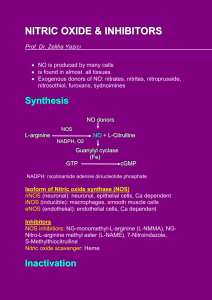Incidence of Myoendothelial Gap Junctions in the Proximal and
advertisement
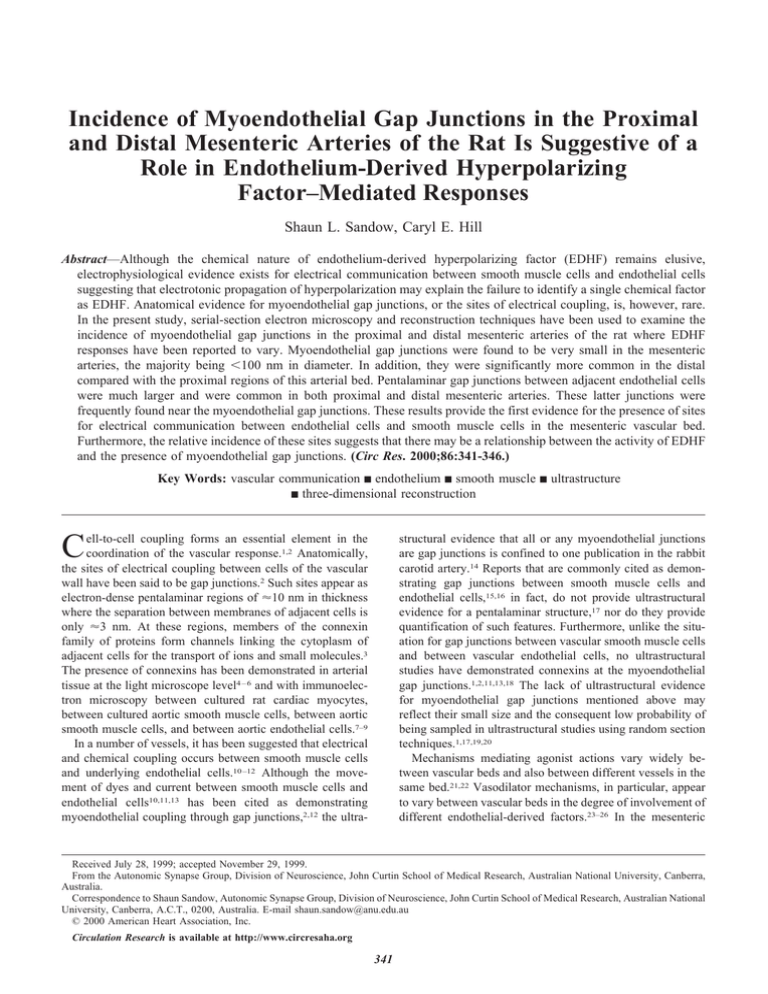
Incidence of Myoendothelial Gap Junctions in the Proximal and Distal Mesenteric Arteries of the Rat Is Suggestive of a Role in Endothelium-Derived Hyperpolarizing Factor–Mediated Responses Shaun L. Sandow, Caryl E. Hill Abstract—Although the chemical nature of endothelium-derived hyperpolarizing factor (EDHF) remains elusive, electrophysiological evidence exists for electrical communication between smooth muscle cells and endothelial cells suggesting that electrotonic propagation of hyperpolarization may explain the failure to identify a single chemical factor as EDHF. Anatomical evidence for myoendothelial gap junctions, or the sites of electrical coupling, is, however, rare. In the present study, serial-section electron microscopy and reconstruction techniques have been used to examine the incidence of myoendothelial gap junctions in the proximal and distal mesenteric arteries of the rat where EDHF responses have been reported to vary. Myoendothelial gap junctions were found to be very small in the mesenteric arteries, the majority being ⬍100 nm in diameter. In addition, they were significantly more common in the distal compared with the proximal regions of this arterial bed. Pentalaminar gap junctions between adjacent endothelial cells were much larger and were common in both proximal and distal mesenteric arteries. These latter junctions were frequently found near the myoendothelial gap junctions. These results provide the first evidence for the presence of sites for electrical communication between endothelial cells and smooth muscle cells in the mesenteric vascular bed. Furthermore, the relative incidence of these sites suggests that there may be a relationship between the activity of EDHF and the presence of myoendothelial gap junctions. (Circ Res. 2000;86:341-346.) Key Words: vascular communication 䡲 endothelium 䡲 smooth muscle 䡲 ultrastructure 䡲 three-dimensional reconstruction C structural evidence that all or any myoendothelial junctions are gap junctions is confined to one publication in the rabbit carotid artery.14 Reports that are commonly cited as demonstrating gap junctions between smooth muscle cells and endothelial cells,15,16 in fact, do not provide ultrastructural evidence for a pentalaminar structure,17 nor do they provide quantification of such features. Furthermore, unlike the situation for gap junctions between vascular smooth muscle cells and between vascular endothelial cells, no ultrastructural studies have demonstrated connexins at the myoendothelial gap junctions.1,2,11,13,18 The lack of ultrastructural evidence for myoendothelial gap junctions mentioned above may reflect their small size and the consequent low probability of being sampled in ultrastructural studies using random section techniques.1,17,19,20 Mechanisms mediating agonist actions vary widely between vascular beds and also between different vessels in the same bed.21,22 Vasodilator mechanisms, in particular, appear to vary between vascular beds in the degree of involvement of different endothelial-derived factors.23–26 In the mesenteric ell-to-cell coupling forms an essential element in the coordination of the vascular response.1,2 Anatomically, the sites of electrical coupling between cells of the vascular wall have been said to be gap junctions.2 Such sites appear as electron-dense pentalaminar regions of ⬇10 nm in thickness where the separation between membranes of adjacent cells is only ⬇3 nm. At these regions, members of the connexin family of proteins form channels linking the cytoplasm of adjacent cells for the transport of ions and small molecules.3 The presence of connexins has been demonstrated in arterial tissue at the light microscope level4 – 6 and with immunoelectron microscopy between cultured rat cardiac myocytes, between cultured aortic smooth muscle cells, between aortic smooth muscle cells, and between aortic endothelial cells.7–9 In a number of vessels, it has been suggested that electrical and chemical coupling occurs between smooth muscle cells and underlying endothelial cells.10 –12 Although the movement of dyes and current between smooth muscle cells and endothelial cells10,11,13 has been cited as demonstrating myoendothelial coupling through gap junctions,2,12 the ultra- Received July 28, 1999; accepted November 29, 1999. From the Autonomic Synapse Group, Division of Neuroscience, John Curtin School of Medical Research, Australian National University, Canberra, Australia. Correspondence to Shaun Sandow, Autonomic Synapse Group, Division of Neuroscience, John Curtin School of Medical Research, Australian National University, Canberra, A.C.T., 0200, Australia. E-mail shaun.sandow@anu.edu.au © 2000 American Heart Association, Inc. Circulation Research is available at http://www.circresaha.org 341 342 Circulation Research February 18, 2000 arterial bed of the rat, for example, Shimokawa et al27 have provided evidence that the importance of endotheliumderived hyperpolarizing factor (EDHF), compared with that of nitric oxide, in endothelium-dependent relaxations increased as vessel size decreased. At present, there are many candidates for an EDHF12,28 –31 (see also References 24 and 32 through 34 for reviews), but there is little agreement as to its nature in resistance vessels such as those of the mesentery.32,33,35–37 Physiological evidence of a role for myoendothelial gap junctions in the actions of EDHF in mesenteric arteries and arterioles has been provided from studies that used the putative gap junction uncoupling agents 18␣- and 18-glycyrrhetinic acid and Gap 27 peptide.12,18,31,38 – 40 Given that myoendothelial gap junctions would provide the sites for the electrotonic conduction of a hyperpolarization from the endothelial cells to the smooth muscle cells,23 there may be no need to propose a chemical identity for EDHF.41 Alternatively, myoendothelial gap junctions may represent the sites for the transfer of a chemical factor that results in hyperpolarization of the adjacent smooth muscle, or there may be a combination of electrical and chemical mechanisms that involve myoendothelial gap junctions, as well as other chemical factors. Whatever the case, what is needed is anatomical evidence for the occurrence of myoendothelial gap junctions and their incidence in vascular beds where vasodilatory mechanisms have been studied. Morphological variation in the vascular wall has been observed between vascular beds, as well as between immature and adult animals.1,42– 46 Previous studies of the distribution of close myoendothelial associations in selected vascular beds using random section methods have suggested that there may be an inverse correlation between the number of such associations and arterial diameter.45,46 It should be noted, however, that these myoendothelial associations were not gap junctions, but rather were regions where the membranes of the adjacent cells were separated by an electron lucent space of ⬇20 nm with no evidence of an intervening basal lamina. Such regions would not be expected to serve as conduits for the propagation of electrical signals, although they may theoretically represent a potential pathway for the passage of chemical signals. In the present study, we have used serial-section electron microscopy to address the question of the existence and size of myoendothelial gap junctions and to investigate the prevalence of such junctions in proximal and distal mesenteric arteries of the rat where changes in the relative importance of nitric oxide and EDHF have been previously described.27 Materials and Methods Animals and Tissue Preparation Three Wistar Kyoto rats aged 4 to 5 weeks postnatal, of either sex, were killed with an overdose of ether anesthetic, and the mesenteric arterial tree supplying a short segment of the ileum was rapidly removed into Krebs solution. The arterial tree was pinned flat on Sylgard (Sylgard 184; Dow Corning) in a small petri dish and immediately immersion-fixed in 2% paraformaldehyde and 1% glutaraldehyde in 0.1 mmol/L sodium cacodylate with 2 mmol/L CaCl2䡠6H2O, pH 7.4, at 37°C for 2 hours and then overnight at room temperature. Tissues were then postfixed in 2% osmium tetroxide in 0.1 mmol/L sodium cacodylate buffer for 1 hour, stained with Figure 1. Diagrammatic representation of the arrangement of endothelial and smooth muscle cells in the proximal arteries of the mesenteric bed of the rat. The dashed lines delineate the area that has been serially sectioned (arrowheads). Endothelial cells (a; green) are arranged parallel to the longitudinal axis of the vessel (open arrows), whereas smooth muscle cells (b; red) are arranged circumferentially to the longitudinal axis of the vessel. Bar⫽50 m. saturated aqueous uranyl acetate for 2 hours, and embedded in Araldite 502 according to conventional procedures. These experiments were carried out under the guidelines of the National Health and Medical Research Council of Australia code of practice for the care and use of animals for scientific purposes, with protocols approved by the Animal Experimentation and Ethics Committee of the Australian National University, Australian Capital Territory, Australia. Serial-Section Electron Microscopy and Reconstruction Fifty transverse serial sections (one segment totaling ⬇5 m of vessel, each from a different animal; Figure 1) of the proximal mesenteric artery, taken as the first-order branch from the superior mesenteric artery, and the distal mesenteric artery, taken as the third-order branch of the superior mesenteric artery, were cut from three animals. These segments were selected to be large enough to effectively sample several smooth muscle cells in each area examined. Low-magnification micrographs (⫻2500) of the central section of each series were taken on plate film on a Hitachi 7100 transmission electron microscope, and the vessel circumference was estimated as the length of the internal elastic lamina. The numbers of myoendothelial gap junctions with characteristic pentalaminar membrane structure were noted throughout the series. These counts were repeated by a separate observer to avoid bias. All myoendothelial gap junctions were followed through serial sections and photographed on plate film at high power (⫻20 000 to ⫻60 000). Reconstruction was performed using the microcomputer imaging device hardware and software system (MCID, version 3.0, Imaging Research, Canada). Photographed myoendothelial gap junction profiles and their surrounding endothelial and smooth muscle cell regions were digitized from contact prints using an HP Scanjet 4C flatbed scanner, at a resolution of 500 dots per inch. Estimates of gap junction surface area were obtained from the reconstructed images using the MCID system. To demonstrate that the preparative conditions were conducive to the preservation of myoendothelial gap junctions, endothelial cell– to– endothelial cell gap junctions were noted in each section of the three series. Four such associations were photographed through serial sections at ⫻20 000 to ⫻50 000 and reconstructed as above. Statistical Analysis Results are expressed as mean⫾SEM. Statistical significance was tested using Student’s t test, and a P value ⬍ 0.05 was taken as significant. Sandow and Hill Vessel Characteristics and the Prevalence of Myoendothelial Gap Junctions in Rat Mesenteric Arteries Proximal (First Order) Distal (Third Order) Vessel circumference, m 499⫾65 363⫾19* Total number of myoendothelial gap junctions/5 m of vessel sectioned 7.3⫾1.8 13.7⫾3.2 Myoendothelial gap junctions/240 m2 of the myoendothelial space 0.70⫾0.14 1.80⫾0.34* Results are mean⫾SEM for 3 different animals. *P⬍0.05. Results The relationship between the morphological arrangement of the smooth muscle and endothelial cells to the area of vessel sampled is shown to scale in Figure 1 for the proximal mesenteric vessels. The dimensions and shape of the smooth muscle cells and endothelial cells were based on published values,42 and our own unpublished results. The distal mesenteric vessels were chosen to be the third-order vessels and, as such, were significantly smaller than the proximal vessels (Table) and within the range quoted for distal vessels by Shimokawa et al.27 Therefore, the 5-m segment sampled in Figure 2. Low-power electron micrographs of transverse sections of the wall of the proximal (a) and distal (b) mesenteric arteries. Proximal vessels had 5 to 6 smooth muscle cells (sc) in their media, whereas distal vessels had 3 to 4 medial smooth muscle cells. Asterisk (*) indicates myoendothelial space; ec, endothelial cells; and l, lumen. Bar⫽10 m. Myoendothelial Gap Junctions and EDHF 343 the distal vessels would be expected to contain fewer smooth muscle cells than would the same length of segment from the proximal vessels. For example, for a spindle-shaped smooth muscle cell with a length of 75 m and width of 3.8 m, the approximate surface area facing the endothelial cell surface is 240 m2 (using the MCID system). Thus, in the proximal arteries, the average area sampled of 2493⫾325 m2 would represent 10.4 smooth muscle cells whereas in the distal arteries the average area sampled of 1813⫾105 m2 would represent 7.5 muscle cells. Proximal mesenteric arteries had 5 to 6 smooth muscle cells in their media (Figure 2a), whereas distal mesenteric arteries had 3 to 4 smooth muscle cells in their media (Figure 2b). The average vessel circumference at the level of the internal elastic lamina, the total number of myoendothelial gap junctions in the areas sampled, and the average number of myoendothelial gap junctions present in an area approximating that of a single smooth muscle cell in the proximal and distal mesenteric arteries can be seen in the Table (n⫽3). Significantly fewer myoendothelial gap junctions per smooth muscle cell were present in proximal compared with distal mesenteric arteries (P⬍0.05; Table). Myoendothelial gap junctions were very small. Of the 22 and 41 myoendothelial gap junctions found in the three 5-m-long cylindrical regions of the proximal and distal mesenteric arteries, respectively, 59% and 85% were apparent in only single sections (that is, they were present in a single section ⬇100-nm thick and were thus ⱕ100 nm in “width” in that plane of section; Figure 3). The largest myoendothelial gap junction observed in the present study had a surface area of 0.08 m2 (Figure 3c). All myoendothelial gap junctions were found on projections arising from the endothelial cells. Reconstruction of myoendothelial gap junctions suggested that there might be two distinct morphological types. The first type was found between the end of a bulbous endothelial cell projection abutting a smooth muscle cell membrane (Figures 3a through 3c and 4d), and the second type involved a similar endothelial cell projection, except that the bulbous end lay in an indentation of the smooth muscle cell membrane (Figures 3d through 3f). Projections of both smooth muscle cells and endothelial cells were commonly found to come into close association with each other in both proximal and distal mesenteric arteries. At these sites, adjacent membranes were separated by 20 to 250 nm, and gap junctions were not found (Figure 4a). These structures may point to the dynamic nature of myoendothelial gap junctions as has been described for other gap junctions.47 Gap junctions between smooth muscle cells were rarely observed, although a systematic serial section examination was not undertaken. On the other hand, endothelial cell–to– endothelial cell gap junctions were present in all sections examined (Figure 4b). Reconstruction of selected endothelial cell–to– endothelial cell associations (Figure 4c) showed that such associations were very large compared with myoendothelial gap junctions (mean area of endothelial cell gap junctions was 0.34⫾0.06 m2; n⫽4). Endothelial cell– to– endothelial cell gap junctions were often found in close proximity to myoendothelial cell gap junctions (Figure 4d). 344 Circulation Research February 18, 2000 Figure 3. Myoendothelial gap junctions. Two types were found: those abutting the smooth muscle cell membrane (a through c; type 1) and those lying in indentations in the smooth muscle cell membrane (d through f; type 2), with the former being most commonly observed. All myoendothelial gap junctions were found on projections arising from endothelial cells (ec). The pentalaminar membrane association (arrowheads) between the endothelial and smooth muscle cell (sc) is shown in panels a and d. In reconstructions of myoendothelial gap junctions (b, c, e, and f), endothelial cells are shown in green, smooth muscle cells in red, and myoendothelial gap junctions in white (arrowheads). In panels c and f, the smooth muscle cell surface has been removed to show the position of the myoendothelial gap junction. Bar⫽1 m for panels b, c, e, and f, 0.5 m for panels a (top) and d (left), and 50 nm for panels a (bottom) and d (right). Because of the rotation of panels b, c, e, and f to optimally show the myoendothelial gap junction, the scale bar is approximate. Discussion The present study is the first to demonstrate and to quantify definitively the presence of pentalaminar myoendothelial gap junctions in the vasculature. These structures provide the site for electrical communication between endothelial cells and smooth muscle cells, as well as for the transfer of small molecules between adjacent cells. Serial-section electron microscopy and reconstruction techniques have shown that these junctions are very small in area, with the majority being ⬍100 nm in diameter. The results thus provide an explanation for the lack of previous reports of myoendothelial gap junctions and support the proposition that random-section electron microscopy and freeze-fracture studies are unlikely to be appropriate techniques to demonstrate these structures systematically. In light of this, it is interesting that other studies have suggested that small gap junctions may not readily be detected with standard thin-section ultrastructural techniques.1,17,19,20 Myoendothelial gap junctions in the mesenteric vascular bed of the rat were significantly more numerous in the smaller-diameter distal compared with the larger-diameter proximal arteries. The results of the present study correlate well with the observations of Shimokawa et al27 in the same mesenteric vascular bed of the rat, in which the importance of EDHF in acetylcholine-induced relaxations increased as vessel size decreased. The data of the present study may therefore support the hypothesis that there is no need to propose a chemical factor as EDHF, but rather, that hyperpolarizations generated in endothelial cells are electrotoni- cally propagated through the myoendothelial gap junctions to the smooth muscle cells.12,13,18,39,40 Alternatively, in view of the evidence in some vascular beds that EDHF is a chemical entity,23,24,32–35,37 myoendothelial gap junctions may represent one pathway by which an endothelium-derived chemical factor may influence the adjacent smooth muscle. In spite of the small size of myoendothelial gap junctions, large gap junctions were frequently found between adjacent endothelial cells. Furthermore, the large endothelial cell gap junctions were commonly found near to the site of a myoendothelial gap junction. On the basis of the arrangement of the cells within the blood vessel wall (see Figure 1), Haas and Duling48 have suggested that endothelial cells form the most favorable pathway for the transmission of electrical signals along blood vessels. The prevalence and large size of the gap junctions seen in the present study between endothelial cells coupled with the paucity of such junctions within the smooth muscle cell layer provide support for this hypothesis. The close relationship between myoendothelial and endothelial gap junctions suggests that myoendothelial gap junctions may also play an important role in the coordination of the vascular response. Whether the pentalaminar membrane structures represent the site of active electrical and chemical communication (see for example, References 3 and 7 through 9) or a later stage in the rapid turnover of free gap junction channels49 remains to be elucidated. In the present study, we have shown that there are approximately two myoendothelial gap junctions per smooth muscle cell at the level of the internal elastic lamina in the Sandow and Hill Myoendothelial Gap Junctions and EDHF 345 Figure 4. Myoendothelial associations and gap junctions between endothelial cells. Projections arising from endothelial cells (ec) with close associations of 20 to 200 nm to smooth muscle cells (sc) were commonly found (a). Those shown represent the closest such projections came to smooth muscle cells. Gap junctions between endothelial cells (b; arrowheads) were reconstructed (c) from serial sections to show that such associations were relatively large compared with myoendothelial gap junctions. Endothelial cells are indicated in green, and endothelial cell gap junctions are in white. The reconstructed endothelial cell gap junctions shown (left to right) have surface areas of 0.22 and 0.3 m2, respectively. The longitudinal axis of the vessel is parallel to the scale bar. Myoendothelial gap junctions (d; left, arrowhead) were often found in close proximity to gap junctions between endothelial cells (d; left, arrowhead with asterisk). The endothelial cell gap junction (d; left) is shown at high magnification in the top right panel, and the myoendothelial gap junction is shown at high magnification in the bottom right panel. Discontinuities in the endothelial cell projections (a; left) are due to their small size. Bar⫽0.5 m for panel a, 100 nm for panel b, 1 m for panels c and d (left), 100 nm for panel d (right, top), and 50 nm for panel d (right, bottom). distal mesenteric vessels. Given the dimensions and anatomical arrangement of the cells in the vessel wall and that there are about three layers of smooth muscle cells in the distal vessels, we estimate that one endothelial cell would be driving 15 to 18 smooth muscle cells. If a myoendothelial gap junction of 100 nm in diameter represents 50 individual gap junctional channels with a total resistance of ⬇70 M⍀ (based on data from References 50 and 51), and the input resistance of a smooth muscle cell is 10 G⍀,52 then clearly one myoendothelial gap junction would be sufficient to produce significant voltage changes in the smooth muscle cell layer, provided that the appropriate current source was present in the endothelial cells. In conclusion, we have shown that myoendothelial gap junctions are present in the mesenteric vascular bed of the rat, that such junctions are very small, and that in this bed their relative incidence is correlated with the relative importance of EDHF as a vascular relaxing factor. These results support the proposition that electrical and/or chemical communication through myoendothelial gap junctions may account for all or part of the responses attributable to EDHF in this vascular bed. Acknowledgments This work was supported by a grant-in-aid from the National Heart Foundation of Australia. We wish to thank Professor David Hirst and Dr John Bekkers for advice regarding the potential biophysical relevance of myoendothelial gap junctions and Dr Bruce Walmsley for critical comments on the manuscript. References 1. Duling BR, Matsuki T, Segal SS. Conduction in the resistance-vessel wall. Contributions to vasomotor tone and vascular communication. In: Bevan JA, ed. The Resistance Vasculature. Totowa, NJ: Humana Press; 1991:193–215. 346 Circulation Research February 18, 2000 2. Christ GJ, Spray DC, el-Sabban M, Moore LK, Brink PR. Gap junctions in vascular tissues. Evaluating the role of intercellular communication in the modulation of vasomotor tone. Circ Res. 1996;79:631– 646. 3. Goodenough DA, Goliger JA, Paul DL. Connexins, connexons, and intercellular communication. Annu Rev Biochem. 1996;65:475–502. 4. Little TL, Beyer EC, Duling BR. Connexin 43 and connexin 40 gap junctional proteins are present in arteriolar smooth muscle and endothelium in vivo. Am J Physiol. 1995;268:H729 –H739. 5. Yeh HI, Lupu F, Dupont E, Severs NJ. Upregulation of connexin43 gap junctions between smooth muscle cells after balloon catheter injury in the rat carotid artery. Arterioscler Thromb Vasc Biol. 1997; 17:3174 –3184. 6. Hong T, Hill CE. Restricted expression of the gap junctional protein connexin43 in the arterial system of the rat. J Anat. 1998;193:583–593. 7. Laird DW, Revel JP. Biochemical and immunocytochemical analysis of the arrangement of connexin43 in rat heart gap junction membranes. J Cell Sci. 1990;97:109 –117. 8. Rennick RE, Connat JL, Burnstock G, Rothery S, Severs NJ, Green CR. Expression of connexin43 gap junctions between cultured vascular smooth muscle cells is dependent upon phenotype. Cell Tissue Res. 1993;271:323–332. 9. Yeh HI, Dupont E, Coppen S, Rothery S, Severs NJ. Gap junction localization and connexin expression in cytochemically identified endothelial cells of arterial tissue. J Histochem Cytochem. 1997;45: 539 –550. 10. von der Weid P-Y, Beny J-L. Simultaneous oscillations in the membrane potential of pig coronary artery endothelial and smooth muscle cells. J Physiol (Lond). 1993;471:13–24. 11. Little TL, Xia J, Duling BR. Dye tracers define differential endothelial and smooth muscle coupling patterns within the arteriolar wall. Circ Res. 1995;76:498 –504. 12. Yamamoto H, Fukuta H, Nakahira Y, Suzuki H. Blockade by 18glycyrrhetinic acid of intercellular electrical coupling in guinea-pig arterioles. J Physiol (Lond). 1998;511:501–508. 13. Beny J-L. Electrical coupling between smooth muscle cells and endothelial cells in pig coronary arteries. Pflugers Arch. 1997;433:364 –367. 14. Spagnoli LG, Villaschi S, Neri L, Palmeri G. Gap junctions in myoendothelial bridges of rabbit carotid arteries. Experientia. 1982;38: 124 –125. 15. Rhodin JAG. Architecture of the vessel wall. In: Bohr DF, Somlyo AP, Sparks HV, eds. The Cardiovascular System. Bethesda, Md: American Physiological Society; 1980:1–31. 16. Kristek F, Gerova M. Myoendothelial relations in the conduit coronary artery of the dog and rabbit. J Vasc Res. 1992;29:29 –32. 17. Sosa-Melgarejo JA, Berry CL. Myoendothelial contacts on the thoracic aorta of rat fetuses. J Pathol. 1992;166:311–316. 18. Chaytor AT, Evans WH, Griffith TM. Central role of heterocellular gap junctional communication in endothelium-dependent relaxations of rabbit arteries. J Physiol (Lond). 1998;508:561–573. 19. Severs NJ. Gap junctions and orientation at the cardiac intercalated disk. Circ Res. 1989;65:1458 –1462. 20. Beny J-L, Connat JL. An electron-microscopic study of smooth muscle cell dye coupling in the pig coronary arteries. Role of gap junctions. Circ Res. 1992;70:49 –55. 21. Mulvany MJ, Aalkjaer C. Structure and function of small arteries. Physiol Rev. 1990;70:921–961. 22. Morris JL, Gibbins IL, Kadowitz PJ, Herzog H, Kreulen DL, Toda N, Clanig A. Roles of peptides and other substances on cotransmission from vascular autonomic and sensory neurons. Can J Physiol Pharmacol. 1995;73:521–532. 23. Mombouli JV, Vanhoutte PM. Endothelium-derived hyperpolarizing factor(s): updating the unknown. Trends Pharmacol Sci. 1997;18:252–256. 24. Edwards G, Weston AH. Endothelium-derived hyperpolarizing factor—a critical appraisal. Prog Drug Res. 1998;50:107–133. 25. Griffith TM, Chaytor AT, Evans WH. Role of gap junctions and Ca2⫹ stores in endothelium-dependent relaxations. Pharmacol Toxicol. 1998; 83:57–59. Abstract. 26. Fleming I, Busse R. NO: the primary EDRF. J Mol Cell Cardiol. 1999; 31:5–14. 27. Shimokawa H, Yasutake H, Fujii K, Owada K, Nakaike R, Fukumoto Y, Takayanagi T, Nagao T, Egashira K, Fujishima M, Takeshita A. The importance of the hyperpolarizing mechanism increases as the vessel size 28. 29. 30. 31. 32. 33. 34. 35. 36. 37. 38. 39. 40. 41. 42. 43. 44. 45. 46. 47. 48. 49. 50. 51. 52. decreases in endothelium-dependent relaxations in rat mesenteric circulation. J Cardiovasc Pharmacol. 1996;28:703–711. Edwards G, Dora KA, Gardner MJ, Garland CJ, Weston AH. K⫹ is an endothelium-derived hyperpolarizing factor in rat arteries. Nature. 1998; 396:269 –272. de Wit C, Esser N, Lehr H-A, Bolz S-S, Pohl U. Pentobarbital-sensitive EDHF comediates ACh-induced arteriolar dilation in the hamster microcirculation. Am J Physiol. 1999;276:H1527–H1534. Doughty JM, Plane F, Langton PD. Charybdotoxin and apamin block EDHF in rat mesenteric artery if selectively applied to the endothelium. Am J Physiol. 1999;276:H1107–H1112. Hutcheson IR, Chaytor AT, Evans WH, Griffith TM. Nitric oxide–independent relaxations to acetylcholine and A23187 involve different routes of heterocellular communication: role of gap junctions and phospholipase A2. Circ Res. 1999;84:53– 64. Feletou M, Vanhoutte PM. The alternative: EDHF. J Mol Cell Cardiol. 1999;31:15–22. Shimokawa H. Primary endothelial dysfunction: atherosclerosis. J Mol Cell Cardiol. 1999;31:23–37. Campbell WB, Harder DR. Endothelium-derived hyperpolarizing factors and vascular cytochrome P450 metabolites of arachidonic acid in the regulation of tone. Circ Res. 1999;84:484 – 488. Vanhoutte PM. Old-timer makes a comeback. Nature. 1998;396: 213–216. Quignard JF, Feletou M, Thollon C, Vilaine TP, Duhault J, Vanhoutte PM. Potassium ions and endothelium-derived hyperpolarizing factor in guinea-pig carotid and porcine coronary arteries. Br J Pharmacol. 1999; 127:27–34. Triggle CR, Dong H, Waldron GJ, Cole WC. Endothelium-derived hyperpolarizing factor(s): species and tissue heterogeneity. Clin Exp Pharmacol Physiol. 1999;26:176 –179. Taylor HJ, Chaytor AT, Evans WH, Griffith TM. Inhibition of the gap junctional component of endothelium-dependent relaxations in rabbit iliac artery by 18␣-glycyrrhetinic acid. Br J Pharmacol. 1998;125:1–3. Dora KA, Martin PEM, Chaytor AT, Evans H, Garland CJ, Griffith TM. Role of heterocellular gap junctional communication in endotheliumdependent smooth muscle hyperpolarization: inhibition by a connexinmimetic peptide. Biochem Biophys Res Comm. 1999;254:27–31. Yamamoto Y, Imaeda K, Suzuki H. Endothelium-dependent hyperpolarization and intercellular electrical coupling in guinea-pig mesenteric arterioles. J Physiol (Lond). 1999;514:505–513. Beny J-L. Electrical communication between endothelial and smooth muscle cells. Proceedings of the International Symposium in New Developments in Smooth Muscle and Endothelial Cell Signaling (ISSMETCS). Nagoya City University, Nagoya, Japan. 1999;1:67. Abstract. Shiraishi T, Sakaki S, Uehara Y. Architecture of the media of the arterial vessels in the dog brain: a scanning electron microscopic study. Cell Tissue Res. 1986;243:329 –335. Miller BG, Connors BA, Bohlen G, Evan AP. Cell and wall morphology of intestinal arterioles from 4- to 6- and 17- to 19-week-old Wistar-Kyoto and spontaneously hypertensive rats. Hypertension. 1987;9:59 – 68. Luff SE. The ultrastructure of arterioles. In: Bevan JA, ed. The Resistance Vasculature. Totowa, NJ: Humana Press; 1991:93–113. Michel RP, Hu F, Meyrick BO. Myoendothelial junctional complexes in postobstructive pulmonary vasculopathy: a quantitative electron microscopic study. Exp Lung Res. 1995;21:437– 452. Sandow SL, Ball EE, Hill CE. Morphological variation may underlie functional differences in neural control of different vascular beds. Soc Neurosci Abstr. 1997;23:1518. Abstract. Spray DC. Gap junction proteins: where they live and how they die. Circ Res. 1998;83:679 – 681. Haas TL, Duling BR. Morphology favors an endothelial cell pathway for longitudinal conduction within arterioles. Microvasc Res. 1997;53:113–120. Chen L, Meng MQ. Compact and scattered gap junctions in diffusion mediated cell-cell communication. J Theor Biol. 1995;176:39 – 45. Veenstra RD. Size and selectivity of gap junction channels formed from different sized connexins. J Bioenerg Biomembr. 1996;28:327–337. Sosinsky GE. Molecular organization of gap junction membrane channels. J Bioenerg Biomembr. 1996;28:297–309. Hirst GDS, Edwards FR. Sympathetic neuroeffector transmission in arteries and arterioles. Physiol Rev. 1989;69:546 – 604.

